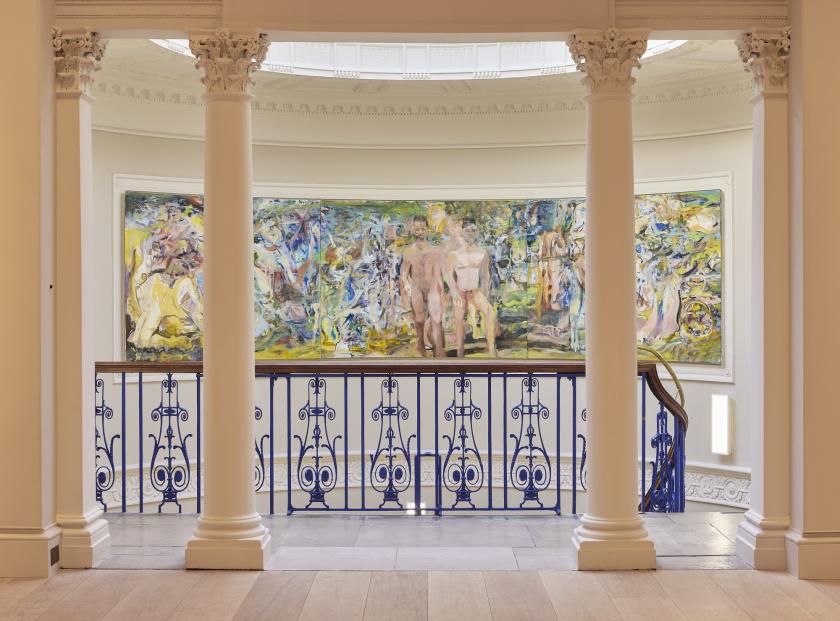The Courtauld Gallery’s dark corners have gone, and with them a certain apt melancholy, that effortlessly summoned the ghosts of Gauguin’s Nevermore, 1897, – the abused and exploited girls of Tahiti; and Delius, who had this painting in his house at Grez-sur-Loing. In the gallery’s murky half-light, the alcohol-softened face of Toulouse-Lautrec’s In a Private Dining Room at the Rat Mort, c.1899, became still more poignant, and Van Gogh’s Peach Trees in Blossom, 1889, seemed still more luminous.
Nostalgia is all well and good, but now that the Courtauld’s impressionist and post-impressionist collections are installed in their new home, they can really be looked at and properly appreciated. The impressive, airy Great Room is the crowning glory of this 18th century building which has been the home of the Courtauld since 1989, redeveloped by Stirling Prize-winning architects Witherford Watson Mann, to create a building that fulfils the needs of the collection today, while keeping a firm hold of its history. Now, surrounded by works from the same period, including Gauguin’s newly acquired illustrated memoir Avant et après, the works form a narrative that honours the gallery’s function as a vital teaching resource, and presents a coherent, stunning, visual feast.
 Charming as it was, the old gallery’s didactic function rather obscured the breadth of the collection, and the gallery’s plum spots were understandably lavished on the perennially popular impressionists. Now that the gallery has been reconfigured, with spaces previously used as offices and storage opened out, the entire collection can be seen to full advantage, with the medieval collections released from its cramped quarters on the ground floor, and now enjoying a new, dedicated gallery.
Charming as it was, the old gallery’s didactic function rather obscured the breadth of the collection, and the gallery’s plum spots were understandably lavished on the perennially popular impressionists. Now that the gallery has been reconfigured, with spaces previously used as offices and storage opened out, the entire collection can be seen to full advantage, with the medieval collections released from its cramped quarters on the ground floor, and now enjoying a new, dedicated gallery.
There is only a modest increase in the number of works on display, and yet new dialogues and juxtapositions have had a refreshing effect that far exceeds the material changes that have actually been made.
Oskar Kokoschka’s triptych The Myth of Prometheus, 1950, has not been displayed for years – as the collection’s largest work there just wasn’t the space – but now it dominates a new gallery dedicated to that artist. Clever hanging means that the painting can be glimpsed from the landing at the top of the staircase, where Cecily Brown’s new painting Unmoored From Her Reflection, 2021 is installed (main picture). The painting, which might constitute a reflection of – or on – Kokoschka’s triptych, was specially commissioned for this curved space, which has not been occupied since the 18th century, when the building was home to the Royal Academy. The painting unfolds as you look at it, with neighbouring paintings, like Manet’s Le Déjeuner sur L’Herbe, c.1863-68, acknowledged in its composition.
Rather movingly, Kokoschka’s triptych is accompanied by a temporary display of photographs by Lee Miller, on loan from the Lee Miller Archive, which show Kokoschka working on the painting in a makeshift studio in the London home of his patron Count Antoine Seilern.
The Courtauld’s wonderful photography collection has been in a somewhat precarious position for years, and it is a great relief to see the matchless holdings of the Conway Library put to innovative use in a new project space, reclaimed from offices. The inaugural exhibition is by the British architectural photographer Anthony Kersting (1916-2008), and features 21 pictures of Kurdistan taken between 1944 and 1946 (above right). Portraits of the persecuted Yazidi people among buildings now destroyed by ISIL are incredibly moving, but also demonstrate rather starkly the historical significance of the archive.
Another small room has been repurposed as a domestic space, furnished with works by the Bloomsbury Group. It is beautifully well-considered, with a specially commissioned rug made to an Omega Workshops design hanging nearby, and available, naturally, to buy from the relaunched shop.
Informative wall texts acknowledge with a light touch the history of both the building and the Courtauld; new acquisitions, such as a gift of 24 drawings by 20th century artists including Joseph Beuys and Louis Soutter, are integrated into the gallery, while retaining their identity as a self-contained collection. This is the Courtauld Gallery of old – just a great deal better.









![SEX MONEY RACE RELIGION [2016] by Gilbert and George. Installation shot of Gilbert & George 21ST CENTURY PICTURES Hayward Gallery](/sites/default/files/styles/thumbnail_125_x_125_/public/mastimages/Gilbert%20%26%20George_%2021ST%20CENTURY%20PICTURES.%20SEX%20MONEY%20RACE%20RELIGION%20%5B2016%5D.%20Photo_%20Mark%20Blower.%20Courtesy%20of%20the%20Gilbert%20%26%20George%20and%20the%20Hayward%20Gallery._0.jpg?itok=3oW-Y84i)





Add comment